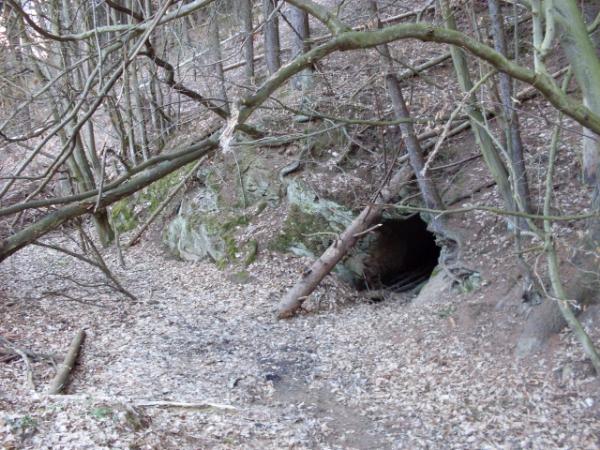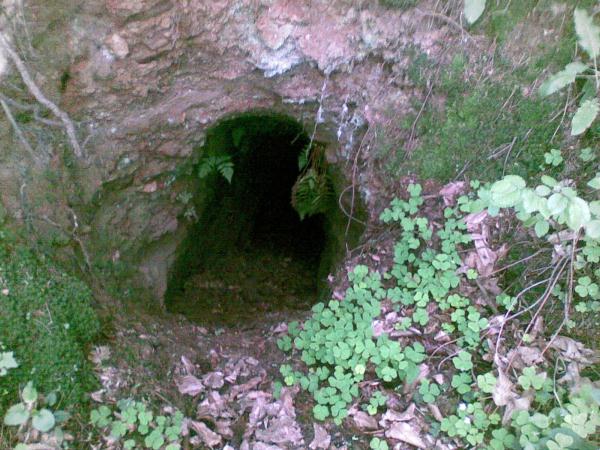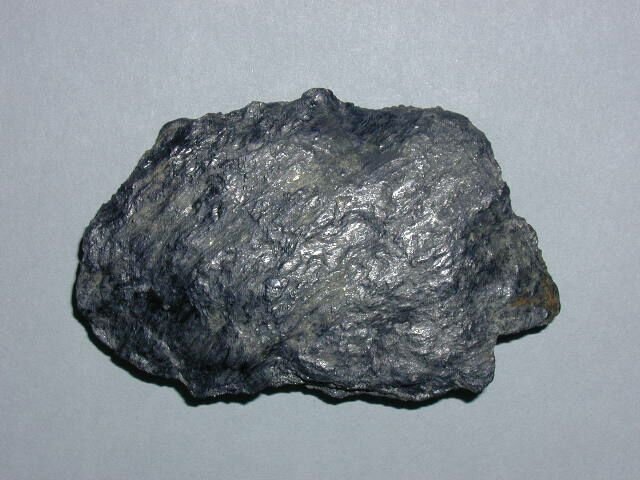Grafitova stola / Graphite Tunnel EarthCache
Grafitova stola / Graphite Tunnel
-
Difficulty:
-

-
Terrain:
-

Size:  (other)
(other)
Related Web Page
Please note Use of geocaching.com services is subject to the terms and conditions
in our disclaimer.
GRAFITOVÁ ŠTOLA / GRAPHITE TUNNEL

Podle dostupných informací se tu provadel v dobe 2. svetové války pruzkum moznosti tezit grafit, ale štola tu prý byla již dríve. V minulem stoleti vedla okolo modra turisticka znacka, a tak o ní vedela rada turistu. Sám jsem ji navštívil poprvé v osmdesátých letech. V té dobe byla ješte ve svahu nad štolou patrná vetrací šachta, do které jsem se osobne propadl. Vzhledem k tomu, že byla ražena šikmo a byla plná sypkého písku, meli kamarádi dost práce s tím, aby me z ní vubec dostali ven, protože jsem jim odjíždel stále hloubeji do štoly a kdybych se nakonec neoprel zády o strop, kdoví jak by to tenkrát dopadlo. Pri príprave earthcache jsem tu šikmou štolu již nenalezl. Domníval jsem se, ze je zavalena, ale 11.5.2010 me mobidik vyvedl z omylu, kdyz ve svem foundit logu napsal, ze stolu nasel a ze je stale dost hluboka na to, aby clovek do ni zahucel. Takze prosim pozor na to!!!
Atribut Dangerous Area je tady kvuli nebezpeci spadnuti do vetraci sachty ve svahu nad stolou!!!
10.11. 2010 jsem podnikl dalsi pruzkum terenu a vetraci sachtu nasel. Vybaven svitidly jsem zjistil, ze pad do hlubin (nebo spise jizda do hlubin) tady opravdu stale hrozi. Sachta se svazuje pod cca 60stupnovym uhlem do hloubky kolem 20 metru, kde zrejme navazuje na grafitovou stolu prichazejici zprava. Sklon se smerem dolu zmirnuje. Dno sachty je pokryte smesi jakesi sotoliny, hliny a listi, ktera pri snaze "vyjit" nahoru klade neprekonatelny odpor. Sance dostat se nahoru je snad v lezeni mezi stenami jako kominem nebo ve vyuziti lana. Jinak steny a strop sachty vypadaji dosti hladce a pevne. Nicmene pokud nejste speleologove, navstevu tohoto podzemi rozhodne nedoporucuji!

V 80. letech už byla štola odríznuta od Blanice náspem dálnice, pod kterým vede propustek umožnující potoku protékajícímu kolem štoly dostat se k Blanici. Tímto tunelem se dá ke štole dostat od reky, ale není to cesta pro klaustrofobiky a už vubec bych ji nedoporucoval absolvovat, pokud máte problem s pateri, protože je možnost uvíznutí v úzkém a nízkém tunelu, kterým se prochází v neustalem predklonu a samozrejme ve vode.
Dnes je toto zajimave misto ponekud stranou. Navštivte a poznejte jej...

POZOR! POZOR! POZOR!
ŠTOLA NENÍ ZAJIŠTENA. Z DUVODU VLASTNÍ BEZPECNOSTI NEVSTUPUJTE DOVNITR!
[CZ]Vaše úloha pro tuto earthcache je zaslat mi na TENTO E-MAIL odpovedi na otázky: "Jakou chemickou znacku má grafit?"
"Jaké regionalni metamorfovane horniny Paleozoika az Proterozoika (archaika) se vyskytuj v tesne blizkosti stoly (2 typy)? Jedna se o dva male protahle (v SZ-JV smeru) utvary uvnitr rozsahle oblasti dvojslidneho svoru v tesne blizkosti stoly."
Jak se nazyva geologická jednotka Ceskeho masivu, ve ktere se nachazi nase stola a ktera tvori jeho jihozapadni a jizni cast. Je povazovana za stare prekambricke jadro obalene mladsimi svrchnoproterozoickymi jednotkami.
Priložte i foto vchodu do grafitové štoly s vaší GPSkou nebo s vaší osobou.
WARNING!!! DON'T ENTER IN THE TUNNEL! IT'S A DANGEROUS AREA!
[EN]Your task for this earthcache is to send me to THIS E-MAIL your answers for the questions: "What is the chemical formula for graphite?"
"What regional metamorphic rocks of paleozoikum to proterozoikum (archaikum) appear close to the tunnel (2 types)? There are two little regions next to the tunnel."
What is the name of tectonic zone (where is the graphite tunnel situated) formed during the Variscan or Hercynian Orogeny (400 to 300 million years ago, during the Devonian and Carboniferous periods), which crops out in the Bohemian Massif and the southern part of the Black Forest and Vosges and contains the highest grade metamorphic rocks of Variscan age in Europe?
Join the photo of the enter of the graphite tunnel with your GPS or your person.

[CZ]Grafit
Pojmenoval A. G. Werner, 1789, chemický vzorec C, je šesterecný nebo klencový minerál. Název pochází z reckého grafein - psáti. Patrí mezi nekovové minerály. Starší název pro grafit je tuha.
Vznik
Tvorí pigment ve vápencích a jílovitých bridlicích. Ložiska grafitu vznikají pri premene usazených hornin ze zbytku organických látek a tvorí vrstvy nebo cockovitá telesa v rulách, svorech, fylitech nebo mramorech. Muže být také magmatického puvodu - nalézá se v pegmatitech.
Morfologie
Tvorí šupinky, ploténky, sférické agregáty, zemité výplne. Krystaly se vyskytují v prírode vzácne, mají tvar hexagonálních tabulek.
Vlastnosti
Fyzikální vlastnosti: Píše po papíre, otírá se o prsty (má tvrdost 1), na omak mastný, hustota 2,1 - 2,3 g/cm³ (kolísá vlivem primíšenin), štepnost dokonalá podle 0001, lom nerovný. Bod tání je cca 3 000 °C, dobre vede elektrický proud. Optické vlastnosti: Barva: cerná, tmave až ocelove šedá. Vryp je tmave ocelove šedý a lesklý. Pruhlednost: nepruhledný. Lesk: kovový až matný Chemické vlastnosti: Tvoren uhlíkem s prímesemi H, N, CO2, CH4, SiO2 aj. V kyselinách nerozpustný, reaguje pouze s HNO3 pri povarení.
Využití
Díky vlastnostem je velmi široké. Z bežných predmetu ho nalezneme v tužkách, tzv. uhlíky jsou soucástí elektromotoru ruzných domácích spotrebicu (mixér, automatická pracka, vysavac aj.) Grafitové tyce slouží pro rízení reakcí v jaderných reaktorech. V metalurgickém prumyslu se vzhledem k jeho znacné tepelné odolnosti z neho vyrábejí tavicí kelímky, vyzdívky nísteje vysoké pece, jako separátor slouží na vymazávání slévárenských forem. Z grafitu se vyrábejí elektrody pro elektrolytickou výrobu hliníku nebo kremíku, elektrody do obloukových pecí na výrobu ocele. Slouží také jako soucást suchých i olejových maziv (grafitová vazelína).
Nalezište
V Cesku:
Ceský Krumlov, Bližná, Velké Tresné, Staré Mesto pod Snežníkem, Cerná v Pošumaví
Svet:
Nemecko – v okolí Pasova magmatická ložiska, v pohorí Harz metamorfní ložiska;
USA – státy Alabama, New Jersey, New York;
Rusko – tunguzská oblast na Sibiri;
Kanada – provincie Québec žilná ložiska;
Šrí Lanka – žilná ložiska;
Madagaskar – metamorfní ložiska;
a další

[EN]Graphite
The mineral graphite is one of the allotropes of carbon. It was named by Abraham Gottlob Werner in 1789 from the Greek ??afe?? (graphein): "to draw/write", for its use in pencils, where it is commonly called lead, as distinguished from the actual metallic element lead. Unlike diamond (another carbon allotrope), graphite is an electrical conductor, a semimetal, and can be used, for instance, in the electrodes of an arc lamp. Graphite holds the distinction of being the most stable form of carbon under standard conditions. Therefore, it is used in thermochemistry as the standard state for defining the heat of formation of carbon compounds. Graphite may be considered the highest grade of coal, just above anthracite and alternatively called meta-anthracite, although it is not normally used as fuel because it is hard to ignite.
There are three principal types of natural graphite, each occurring in different types of ore deposit:
Crystalline flake graphite (or flake graphite for short) occurs as isolated, flat, plate-like particles with hexagonal edges if unbroken and when broken the edges can be irregular or angular;
Amorphous graphite occurs as fine particles and is the result of thermal metamorphism of coal, the last stage of coalification, and is sometimes called meta-anthracite. Very fine flake graphite is sometimes called amorphous in the trade;
Lump graphite (also called vein graphite) occurs in fissure veins or fractures and appears as massive platy intergrowths of fibrous or acicular crystalline aggregates, and is probably hydrothermal in origin.
Properties
Graphite is a layered compound. In each layer, the carbon atoms are arranged in a hexagonal lattice with separation of 0.142 nm, and the distance between planes is 0.335 nm. The two known forms of graphite, alpha (hexagonal) and beta (rhombohedral), have very similar physical properties (except that the graphene layers stack slightly differently). The hexagonal graphite may be either flat or buckled. The alpha form can be converted to the beta form through mechanical treatment and the beta form reverts to the alpha form when it is heated above 1300 °C. The layering contributes to its lower density.
The acoustic and thermal properties of graphite are highly anisotropic, since phonons propagate very quickly along the tightly-bound planes, but are slower to travel from one plane to another.
Graphite can conduct electricity due to the vast electron delocalization within the carbon layers (a phenomenon called aromaticity). These valence electrons are free to move, so are able to conduct electricity. However, the electricity is only conducted within the plane of the layers.
Graphite and graphite powder are valued in industrial applications for its self-lubricating and dry lubricating properties. There is a common belief that graphite's lubricating properties are solely due to the loose interlamellar coupling between sheets in the structure. However, it has been shown that in a vacuum environment (such as in technologies for use in space), graphite is a very poor lubricant. This observation led to the discovery that the lubrication is due to the presence of fluids between the layers, such as air and water, which are naturally adsorbed from the environment. This molecular property is unlike other layered, dry lubricants such as molybdenum disulfide. Recent studies suggest that an effect called superlubricity can also account for graphite's lubricating properties. The use of graphite is limited by its tendency to facilitate pitting corrosion in some stainless steel, and to promote galvanic corrosion between dissimilar metals (due to its electrical conductivity). It is also corrosive to aluminium in presence of moisture. For this reason, the US Air Force banned its use as a lubricant in aluminium aircraft, and discouraged its use in aluminium-containing automatic weapons. Even graphite pencil marks on aluminium parts may facilitate corrosion. Another high-temperature lubricant, hexagonal boron nitride, has the same molecular structure as graphite. It is sometimes called white graphite, due to its similar properties.
When a large number of crystallographic defects bind these planes together, graphite loses its lubrication properties and becomes what is known as pyrolytic carbon. This material is useful for blood-contacting implants such as artificial heart valves. It is also highly diamagnetic, thus it will float in mid-air above a strong magnet.
Natural and crystalline graphites are not often used in pure form as structural materials, due to their shear-planes, brittleness and inconsistent mechanical properties.
History
Some time before 1565 (some sources say as early as 1500), an enormous deposit of graphite was discovered on the approach to Grey Knotts from the hamlet of Seathwaite in Borrowdale parish, Cumbria, England, which the locals found very useful for marking sheep. This particular deposit of graphite was extremely pure and soft, and could easily be broken into sticks. This remains the only deposit of graphite found in this packed form.
Uses of natural graphite
Natural graphite is mostly consumed for refractories, steelmaking, expanded graphite, brake linings, and foundry facings-lubricants. Graphene, which occurs naturally in graphite, has unique physical properties and might be one of the strongest substances known; however, the process of separating it from graphite will require some technological development before it is economically feasible to use it in industrial processes.
Occurrence
Minerals associated with graphite include quartz, calcite, micas, iron meteorites, and tourmalines. Graphite has various other characteristics. Thin flakes are flexible but inelastic, the mineral can leave black marks on hands and paper, it conducts electricity, and displays superlubricity. Its best field indicators are softness, luster, density and streak.
According to the United States Geological Survey (USGS), world production of natural graphite in 2008 was 1,110 thousand tonnes (kt), of which the following major exporters are: China (800 kt), India (130 kt), Brazil (76 kt), North Korea (30 kt) and Canada (28 kt). Graphite is not mined in US, but US production of synthetic graphite in 2007 was 198 kt valued at $1.18 billion. US graphite consumption was 42 kt and 200 kt for natural and synthetic graphite, respectively.
Graphite mining, beneficiation, and milling
Graphite is mined around the world by both open pit and underground methods. While flake graphite and amorphous graphite are both mined open pit and underground, lump (vein) graphite is only mined underground in Sri Lanka. The open pit mines usually employ equipment (i.e. bulldozers) to scoop up the ore, which is usually put in trucks and moved to the plant. Since the original rock is usually lateritized or weathered, this amounts to moving dirt with flecks or pieces of graphite in it from the pit (blasting is seldom required). The underground graphite mines employ drilling and blasting to break up the hard rock (ore), which is then moved by mine cars pulled by a locomotive, or moved by automotive vehicles, to the surface and then to the plant. In less-developed areas of the world, the ore can be mined by pick and shovel and transported by mine cars pushed by a laborer or by women carrying baskets of ore on their heads.
Graphite usually needs beneficiation, although thick-bedded amorphous graphite and vein graphite is almost always beneficiated, if beneficiated at all, by laborers hand-picking out the pieces of gangue (rock) and hand-screening the product. The great majority of world flake graphite production is crushed and ground if necessary and beneficiated by flotation. Treating graphite by flotation encounters one big difficulty: graphite is very soft and "marks" (coats) the particles of gangue. This makes the "marked" gangue particles float off with the graphite to yield a very impure concentrate. There are two ways of obtaining a saleable concentrate or product: regrinding and floating it again and again (up to seven times) to obtain a purer and purer concentrate, or by leaching (dissolving) the gangue with hydrofluoric acid (for a silicate gangue) or hydrochloric acid (for a carbonate gangue).
In the milling process, the incoming graphite products and concentrates can be ground before being classified (sized or screened), with the coarser flake size fractions (below 8 mesh, 8-20 mesh, 20-50 mesh) carefully preserved, and then the carbon contents are determined. Then some standard blends can be prepared from the different fractions, each with a certain flake size distribution and carbon content. Custom blends can also be made for individual customers who want a certain flake size distribution and carbon content. If flake size is unimportant, the concentrate can be ground more freely. Typical final products include a fine powder for use as a slurry in oil drilling; in zirconium silicate, sodium silicate and isopropyl alcohol coatings for foundry molds; and a carbon raiser in the steel industry ( Synthetic graphite powder and powdered petroleum coke can also be used as carbon raiser)(Earth Metrics, 1989). Rough graphite is typically classified, ground, and packaged at a graphite mill; often the more complex formulations are also mixed and packaged at the mill facility. Environmental impacts from graphite mills consist of air pollution including fine particulate exposure of workers and also soil contamination from powder spillages leading to heavy metals contaminations of soil. Dust masks are normally worn by workers during the production process to avoid worker exposure to the fine airborne graphite and zircon silicate.
[CZ]/[EN] Links:
DEJINY DOLOVÁNÍ GRAFITU VE STARÉM MESTE POD SNEŽNÍKEM
Historie dolování ve meste Ceský Krumlov
History of Mining in Ceský Krumlov
minerals.net
ZPRAVA O ORIENTACNI PROHLIDCE NEKTERYCH JIHOCESKYCH GRAFITOVYCH VYSKYTU
Vyhledávání starých dulních del na území stredoceského kraje a Prahy, II.etapa



Additional Hints
(Decrypt)
an hcngv finuh h cbgbxn
Zraqryrwri, trbybtvpxn zncn